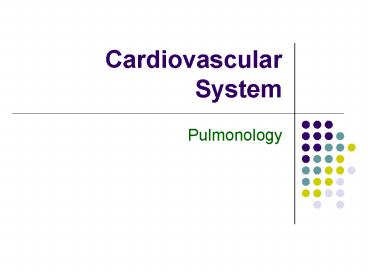Cardiovascular System - PowerPoint PPT Presentation
1 / 15
Title:
Cardiovascular System
Description:
Cardiovascular System Pulmonology Physiology Arteries - carry oxygenated blood away 2 types Muscular regulate blood flow to major organs Elastic major blood ... – PowerPoint PPT presentation
Number of Views:138
Avg rating:3.0/5.0
Title: Cardiovascular System
1
Cardiovascular System
- Pulmonology
2
Physiology
- Arteries - carry oxygenated blood away
- 2 types
- Muscular regulate blood flow to major organs
- Elastic major blood carriers (allow for sudden
change in blood pressure) - Veins carry blood back to
- Small amt of muscle tissue
- Supported by muscle contraction (causes pressure)
- Presence of valves
3
Heart Action
- Diastole
- Atria ventricles relaxed
- Blood fills
- 70 of filling occurs
- Systole
- Contraction phase
- Functioning of mitral and tricuspid valves
- Stroke Volume amt pumped into aorta from a
single contraction - CO HR x SV
4
Factors Affecting BP
- Factor Effect Mechanism
- Blood vol Decrease Dec. fluid
- Vasodilation Decrease systemic cap. gt
fluid volume - Inc. extracel fluid Increase BP inc. to move
- nutrients
- Renal Failure Increase same
5
Symptoms
- Dyspnea
- Decreased CO, shortness of breath
- Palpitations
- Arrhythmia, skipped beats, fluttering
- Claudication
- Impaired gait due to decreased blood flow to LE
6
Loss of Consciousness
- Syncope - Fainting
- Sudden peripheral vasodilation (orthostatic
syncope) - Inc. intracranial pressure (intracranial
bleeding) - Severe reduction in CO (heart failure)
7
Pain Patterns
- Cardiac
- Indicative of spinal levels C3 T4
- Radiating pain down throat/neck medial side
left arm - Vascular
- Sharp tearing/throbbing pain
8
Assessment
- Auscultation
- 1st sound closing of mitral tricuspid valves
ventricular systole beginning - 2nd sound aortic pulmonary valves closing
ventricular systole ending - Respiration Rate
- 10 15 breaths/minute
- Blood pressure
- Systolic 100 140 mmHg
- Diastolic 70 -90 mmHg
- Consistent readings of 140/90 hypertension
9
Issues of Concern
- Sudden Death
- Greater incidence in males
- Congenital issues
- Risk Factors
- Stress
- Electrolyte imbalance
- Dehydration
- Excessive BT
- Sudden cessation of activity
10
Hypertrophic Cardiomyopathy
- Enlarged heart
- Hypertrophy in BOTH ventricles
- Left ventricular hypertrophy
- Right ventricular hypertrophy
- Abnormal myocardial fibers form asymmetrical
hypertrophy
11
Valve Disorders
- Mitral, Aortic, tricuspid, Pulmonary
- Stenosis narrowing blood flow restriction
- Prolapse allowing back flow of blood
- MVP (mitral valve prolapse)
12
Hypertension
- HTN
- Resting BP greater than 140/90 on 3 consecutive
days - Risk factors
- Diet
- Chronic Stress
- Obesity
- Smoking
13
Blood Disorders
- Anemia
- Decrease hemoglobin or RBC volume
- Effects on performance
- Risk factors
- Malnutrition
- Chronic disease
- Prolonged training
- Long term use of NSAIDs
- Dilutional Anemia caused by training
- ?increased blood volume but not RBC
- Temporary condition
14
Blood Disorders cont.
- Sickle Cell Anemia
- Recessive genetic trait causing abnormal shaped
RBCs that in turn inhibit proper binding of
oxygen - Thoracic Outlet Syndrome
- Vascular disorder
- Occlusion of subclavian or axillary artery
- Signs/symptoms
- Cyanosis
- Adsons test
15
Blood Disorders cont.
- Deep Vein Thrombosis
- Results from long term immobilization
- Pooling of blood in veins thrombus
- Homans sign
- Headaches
- Migraine are vascular based

